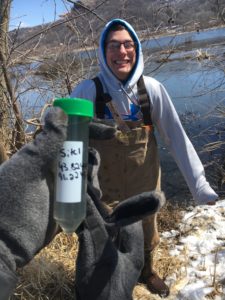Posted p.m. Monday, June 4, 2018

Are rain gardens effective at filtering out runoff pollutants? Is the water quality in Myrick Marsh impacted by the use of road salts? Is a local elementary school’s walking school bus exposing children to dangerous levels of particulate pollution?
UWL environmental chemistry students take science to the streets
Are rain gardens effective at filtering out runoff pollutants? Is the water quality in Myrick Marsh impacted by the use of road salts? Is a local elementary school’s walking school bus exposing children to dangerous levels of particulate pollution? UW-La Crosse environmental chemistry students used the scientific process to answer these questions and others spring semester. Nadia Carmosini, assistant professor of Chemistry, aimed to show her students that basic chemical principles can be applied to real-world questions communities face. The Chemistry Department has learned from employers about the importance of developing graduates with the ability to work on teams and think critically. Carmosini challenged her students to do this by taking a research question from beginning to end — from developing a hypothesis and designing the experiment to collecting data and delivering results. Her efforts to develop these skills through hands-on, community-based projects reflects the wider university goals — strategic pillars — of transformational education and community engagement. [caption id="attachment_52297" align="alignright" width="225"] Alex Morgan, pictured here, and his group took water samples at Myrick Marsh to find out if water quality in the marsh is impacted by the use of road salts at levels that could be detrimental to aquatic ecosystems. Two separate groups in the class found that sampled waters did not exceed levels of concern. Photo by student Elexius Passante.[/caption]
It also demonstrates an area where UWL will continue to grow. A recent $2 million gift from Prairie Springs: The Paul Fleckenstein Trust supports research and scholarship at UWL in the areas of environmental studies and education, wildlife habitat protection, wildlife protection, conservation and ecological technology. More broadly, the gift will help create future environmental leaders.
May graduate Austin Hamlin, who took Carmosini’s course this spring, says there is a disconnect between the general public and scientific community when it comes to the way humans are impacting their environment. He wants to be part of a future that bridges that gap.
“The main reason I took this class is because it is something I care about,” says Hamlin, who is now working at Milwaukee’s South Shore Water Reclamation Facility. “I am personally interested in our environment and problems we are facing.”
Hamlin says the course gave him knowledge to explain, for example, why the vast majority of scientists are certain that human emissions are warming the planet or why a parking lot has the potential to be bad for nearby water resources.
He learned the latter through his class research project. His team studied the efficacy of La Crosse rain gardens in filtering out contaminants from storm water runoff before they end up in area waters. Because of the large scope of their project, the results by semester’s end were inconclusive. Yet they paved the way for continued student research next year, says Carmosini.
Alex Morgan, pictured here, and his group took water samples at Myrick Marsh to find out if water quality in the marsh is impacted by the use of road salts at levels that could be detrimental to aquatic ecosystems. Two separate groups in the class found that sampled waters did not exceed levels of concern. Photo by student Elexius Passante.[/caption]
It also demonstrates an area where UWL will continue to grow. A recent $2 million gift from Prairie Springs: The Paul Fleckenstein Trust supports research and scholarship at UWL in the areas of environmental studies and education, wildlife habitat protection, wildlife protection, conservation and ecological technology. More broadly, the gift will help create future environmental leaders.
May graduate Austin Hamlin, who took Carmosini’s course this spring, says there is a disconnect between the general public and scientific community when it comes to the way humans are impacting their environment. He wants to be part of a future that bridges that gap.
“The main reason I took this class is because it is something I care about,” says Hamlin, who is now working at Milwaukee’s South Shore Water Reclamation Facility. “I am personally interested in our environment and problems we are facing.”
Hamlin says the course gave him knowledge to explain, for example, why the vast majority of scientists are certain that human emissions are warming the planet or why a parking lot has the potential to be bad for nearby water resources.
He learned the latter through his class research project. His team studied the efficacy of La Crosse rain gardens in filtering out contaminants from storm water runoff before they end up in area waters. Because of the large scope of their project, the results by semester’s end were inconclusive. Yet they paved the way for continued student research next year, says Carmosini.
Carmosini aims to have students repeat the projects and collect more data in future semesters — as most projects offered a good start, but showed a need for additional sampling. Still some results from the class are conclusive. Hamlin was one of several students to personally thank Carmosini for the opportunity her class provided. “This class really challenged me,” he explains. “To take the scientific process through the full cycle from asking a question to writing a paper is huge. We can now understand what it would be like to be an environmental chemist and contribute to knowledge that can be disseminated to the public and influence policy.”“This class really challenged me.”
